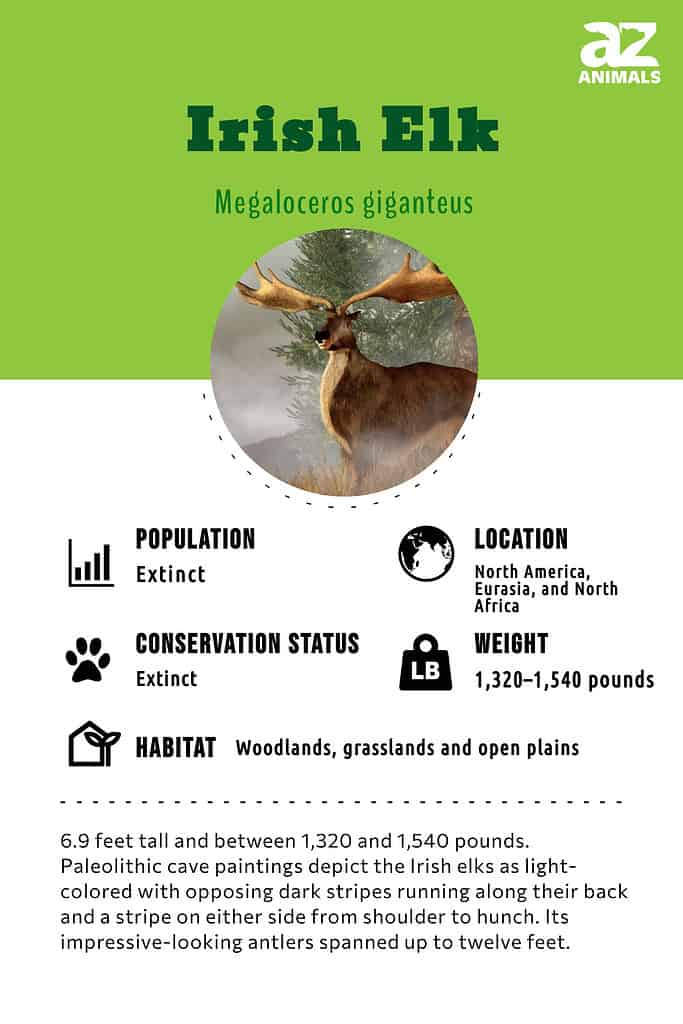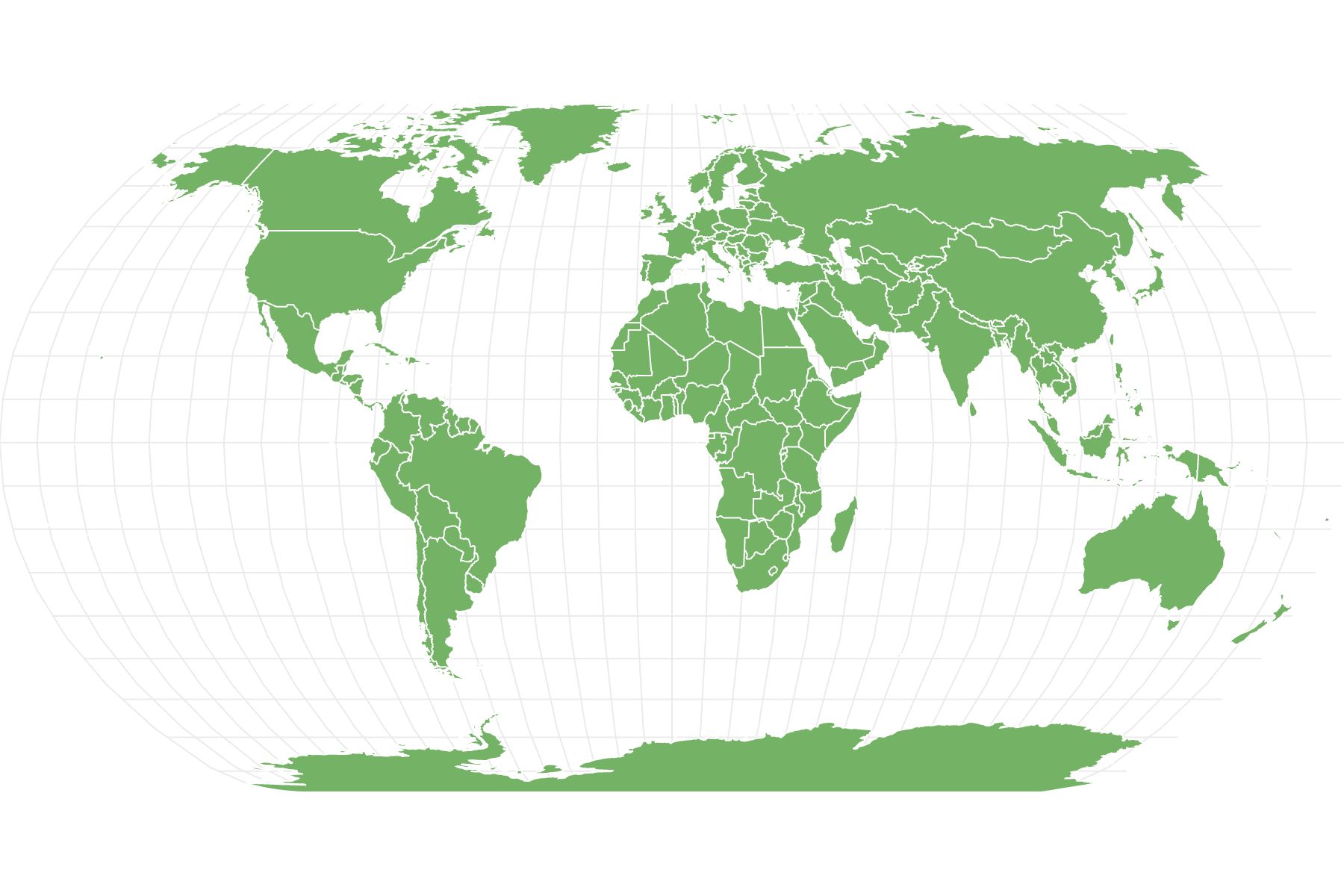Irish Elk
Megaloceros giganteus
The Irish elk had the biggest antlers of any known deer species.
Advertisement
Irish Elk Scientific Classification
- Kingdom
- Animalia
- Phylum
- Chordata
- Class
- Mammalia
- Order
- Artiodactyla
- Family
- Cervidae
- Genus
- Megaloceros
- Scientific Name
- Megaloceros giganteus
Read our Complete Guide to Classification of Animals.
Irish Elk Conservation Status
Irish Elk Facts
- Group Behavior
- Solitary
- Fun Fact
- The Irish elk had the biggest antlers of any known deer species.
- Biggest Threat
- Humans, hyenas
- Most Distinctive Feature
- The Irish elk had massive antlers
- Distinctive Feature
- Massive head
- Other Name(s)
- Giant deer or Irish deer
- Habitat
- Woodlands, grasslands and open plains
- Predators
- Hyenas
- Diet
- Herbivore
- Lifestyle
- Solitary
- Favorite Food
- Leaves, grasses, herbs, shrubs, fruits, and stems
- Common Name
- Irish elk
- Special Features
- Massive antlers
View all of the Irish Elk images!
The Irish Elk (Megaloceros giganteus), also popularly referred to as the giant deer, is an extinct deer species that lived during the Pleistocene Epoch, 2.6 million years ago, till about 11,000 years ago. It is known for its massive size and enormous antlers, which were up to 12 feet long. Many scientists argue that its extinction was largely a result of starvation triggered by climate change and human hunting. As opposed to its name, it is neither an elk nor was it exclusively Irish.

Description and Size

The genus name “Megaloceros” means” great
antler
,” a reference to the deer’s massive antlers.
©Dima Moroz/Shutterstock.com
Irish elk is an extinct deer species within the Cervidae family. Experts consider this deer the biggest deer species to ever walk the North American continent, Eurasia, and North Africa during the Pleistocene Epoch.
Their common name is a result of misidentification. In the early days of their discovery, the antlers were commonly unearthed in Ireland, and the scientists that found them mistook them for the elk, which were once abundant on the island where the bones were found. However, it is misleading because this animal’s range was not restricted to Ireland and is not closely related to the elks.
The genus name “Megaloceros” means” great antler,” a reference to the deer’s massive antlers. The Irish elk is also called giant deer, a fitting name considering the massive size of this deer. It stood at 6.9 feet at the shoulders and weighed between 1,320 and 1,540 pounds. This deer is one of the heaviest old-world deer after Cervalces latifrons. The head-to-body length of the Irish elk was in the range of 9–10 feet.
Irish elks had powerful bones with thick skulls and concave frontals. Their jaws had no upper canines. Fossil finds reveal they had 12.8 inches long molars. Paleolithic cave paintings depict the Irish elks as light-colored animals with opposing dark stripes running along their back and a stripe on either side from shoulder to hunch. Its impressive-looking antlers spanned up to twelve feet.
Only males had antlers. Without antlers, females were 10-15% shorter than males. The antlers were mostly for impressing females. During mating season, males often fought with the antlers over females, who would mate with the victors.
Diet
Like all deer, the Irish elk was herbivorous. Scientists think they ate a lot of leaves, grasses, herbs, shrubs, fruits, and stems. The giant deer followed a mixed eating pattern of grazing and feeding along with leaf browsing. Their massive size meant they could reach the top of trees and shrubs to get food.
However, being big also meant they needed to eat a lot of fresh foliage daily to maintain their strength and support antler growth. They also needed nutritionally rich forage. Their diet most likely included terrestrial and aquatic plants.
Habitat
The Irish elk had an extensive range in the Eurasian region. Their home range extended from the Atlantic Ocean in the West to Lake Baikal in the East. They lived during the Pleistocene Epoch and survived until about 11,000 years ago.
Although the giant deer roamed across various locations in Europe, the best-preserved antlers have been found in Ireland. It is believed to have roamed the boreal steppe woodlands regions of Ireland along with ancient humans. These regions had a lot of pine and spruce, which would have been their major food source. They lived in grasslands and open plains as well.
Weather conditions in Ireland at the end of the last ice age were perfect for fossil preservation. Fossils from the late Pleistocene era have also been found far east, in areas like China and Siberia.

The Irish elk had an extensive range in the Eurasian region, extending from the Atlantic Ocean in the West to Lake Baikal in the East.
©Daniel Eskridge/Shutterstock.com
Threats and Predators
Marks on Fossil bones suggest that the Irish elk was prey for hyenas that usually dragged their bodies into caves. Humans would have constituted significant threats to them as well. While there isn’t enough evidence to show deer hunting by humans, the expansion of Neolithic settlements was dominant during the latter period of their existence. Climate change was a huge threat to their feeding and grazing, and wild animals such as the cave lion and Sabre-toothed tiger would also have attacked them.
History, Evolution, Discoveries, and Fossils
The oldest fossils of the giant deer found date back 400,000 years ago in Ireland. The more recent finds are from deer living about 8,000 years ago. In 1746, the first fossil, which consisted of a skull and an antler, was discovered in Yorkshire, England. In 1781, palaeontologists made the first fossil discovery in continental Europe in Germany. Fossils of the Irish elk have also been found in France, Austria, Britain, Italy, and Central Asia.
The best fossil collection can be found at the National Museum of Ireland. The museum houses ten complete deer skeletons and over 400 partial remains. Some of the most famous fossils found so far are from Ireland. Locations of the most notable finds include Ballybetagh Bog in Glencullen County, Dublin, where over 100 deer skeletons were discovered. Fossils in Ireland were discovered in peat bogs, lakes, and caves.
Fossilized remains of the Irish elk were also found in Maybole, Ayrshire, in Scotland, in 1837. These remains were preserved in peats and bogs before and after the Ice Age, which means it is one of Scotland’s most geologically recent fossil finds.
Extinction
The first wave of extinction for the giant deer happened 12,000 years ago when it disappeared from Ireland altogether. This soon extended to Britain and, later on, all of Europe. A combination of factors triggered the extinction. The rapidly changing climatic condition made food scarce, and since they needed a lot of food to support their massive size and big antlers, they simply couldn’t keep up.
As the climate warmed, parklands and grasslands receded, and forests became widespread, making it impossible for the animals to graze and grow. Early human settlements might have also wiped out the antlers as humans had large appetites for game animals.
It has also been posited that the antlers contributed to the Irish elk’s demise and extinction. Their massive size became a disadvantage that interfered with the deer’s natural lifestyle. They would get caught up in trees, and as such, hunters and predators easily killed them off until they became extinct.
Similar Animals
Similar animals to the Irish Elk include:
- Alaskan Moose — Alaskan moose and Irish elks are considered among the largest deer species ever. They have an average weight of 1,300 pounds and stand at about seven feet.
- Cervalces latifrons — The broad-fronted moose stood at about 7ft and weighed more than 2,000 pounds. It is quite similar to the Irish elk in terms of body mass, weight, and the fact that they walked the earth around the same time – The Pleistocene era.
- Cervalces scott — This is also known as the elk moose or stag moose. It is an extinct species of large-sized deer native to North America. Like the Irish elk, this giant moose lived during the Late Pleistocene Epoch. It is known for its massive size and complex antlers.
Related Animals
View all 39 animals that start with IIrish Elk FAQs (Frequently Asked Questions)
When was the Irish elk alive?
The Irish elk lived about 2.6 million years ago during the Pleistocene epoch. The last known deer died around 7,700 years ago.
How big was the Irish elk?
The Irish elk stood at six feet 11 inches and weighed an average of 1,300 pounds. It is still regarded as the heaviest known cervine to date. It also had the largest antlers of any known deer.
Why did Irish elk go extinct?
A combination of factors led to the disappearance of the Irish elk. Changing climatic conditions led to the decline of their usual habitat and made it difficult to find food. Their large antlers also got in the way, making it difficult for them to navigate the growing woodland habitat. Finally, human activities and predators led to their decline.
Thank you for reading! Have some feedback for us? Contact the AZ Animals editorial team.
Sources
- Berkeley, Available here: https://ucmp.berkeley.edu/mammal/artio/irishelk.html
- Wikipedia, Available here: https://en.wikipedia.org/wiki/Irish_elk
- Britannica, Available here: https://www.britannica.com/animal/Irish-elk

















